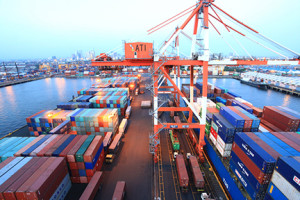
The private sector is proposing several measures for the government to undertake in order to ease port utilization expected to be made worse by the five-day holiday in honor of the Papal visit.
The Private Sector-Technical Working Group (PS-TWG), in a press conference on January 8, said the hard work of the past six months to ease port congestion “may all go to waste” if the government and the private sector are unable to get their act together during the Feast of the Black Nazarene (Jan 9) and the five-day papal visit from January 15 to January 19.
Ernesto Ordoñez, co-chair of the PS-TWG, said that “if companies and government institutions do not cooperate in the next two weeks, we will be back to square one.”
The group projects port utilization to increase by 3% a day during the break, likely reaching 107% by the end of the Pope’s visit.
Statistics from Manila South Harbor operator Asian Terminals Inc. showed that utilization rates had been swinging from 78% on December 13, 2014 to 92% on December 22, to 79% on December 25 and 99% on January 1, 2015.
On January 7, utilization at the South Harbor reached 103%, down from 106% the day before and far from the ideal 70%.
Open routes
One of the measures the group recommends is to keep routes open during the papal visit. PS-TWG said one of the key challenges is that truck bans are likely to be imposed during the five-day visit, and a blanket truck ban “dramatically lowers the efficiency of trade to and from the port.”
The City Government of Manila as well as the Metro Manila Development Authority already advised the public of the closure of the roads where Pope Francis will be passing, including those leading to and from the Manila Cathedral in Intramuros, University of Sto. Tomas in Espana, and Quirino Grandstand in Luneta.
George Fermin of the Alliance of Concerned Truck Owners and Organizations said the ban “need not cover every hour of the Pope’s five-day trip.” The group said the Pope only arrives in the late afternoon of January 15 and will be in Leyte the whole day of January 17. The group also asks for alternative routes to and from the port during the visit.
Another suggestion is for the Bureau of Customs (BOC) to provide a skeletal workforce to conduct examination and processing of goods so that clearance can be given for shipments to leave the port.
BOC last year had announced that its offices at the Port of Manila and Manila International Container Port will be closed for the Pope’s visit from January 16 to January 18 and resume regular operations on January 19.
In his last press conference last year, Customs Commissioner John Phillip Sevilla said BOC had consulted with the Philippine Ports Authority (PPA) and the Manila port operators before announcing this work schedule.
Make or break
Earlier, PPA acknowledged that the next few days before the papal visit “will make or break the port decongestion efforts being carried out by the government.”
The port authority said that if yard utilization at the two Manila ports remains at current levels in the next few days, “it will easily bring back the ports to congestion level” after the conclusion of the papal visit, since majority of activities are concentrated in the City of Manila.
The historic visit is expected to attract waves of people from all walks of life.
PPA general manager Atty. Juan C. Sta. Ana said that unlike the recent nine-day Christmas break when all roads were open, almost all major routes to and from the Manila ports will be closed to accommodate the papal festivities which will “slow down, if not paralyze,” port operations.
In 1995, Pope John Paul II’s visit to Manila to celebrate World Youth Day slowed down port operations for a couple of days, but during that time there was no congestion.
“PPA, along with the Cabinet Cluster headed by CabSec (Cabinet Secretary) Jose Rene Almendras, is appealing to all cargo owners with cleared cargoes pending before the two ports to immediately pick those up soonest to vacate as much space as possible,” Sta. Ana said in a statement.
“We need the spaces in preparation for a worst-case scenario to accommodate the incoming import cargoes from vessels,” he stressed.
“We are anticipating difficulty accessing the ports during the papal visit but we do not expect the vessels to slow down in bringing in cargoes to the country, so we are asking the participation of each stakeholder to maintain our decongestion efforts,” he added.
PPA said data from port operators showed that combined yard utilization on December 24, which signaled the start of the nine-day holiday break, was 89%, up from 79%.
The Port Congestion-Multisectoral Working Group had projected port congestion to increase by 3% a day during the long Christmas break, likely reaching 107% by the end of the holidays. PPA said the group “is again painting such kind of scenario during the papal visit.”
As of January 7, the number of vessels waiting at the pilot station went up to 17, excluding the five currently docked at Manila South Harbor and seven at the Manila International Container Terminal, PPA said.
“When we implemented the measures at the height of the port congestion, we were able to move as much as 2,000 containers on Saturdays and Sundays. But now that the situation has improved, importers move only about 50 to 100 containers during weekends,” Almendras said.
He also noted that the volume of refrigerated containers in Manila ports is double than the normal volume.
“We have to move out some 60,000 empty containers,” Almendras said.
Despite the long holiday recently, the Cabinet official said the Port of Manila did not return to past congestion levels, and that traffic inside the port “has been moving really well.”
“No shipments were delayed. We expect the volume to normalize by February,” he noted. – Roumina Pablo





